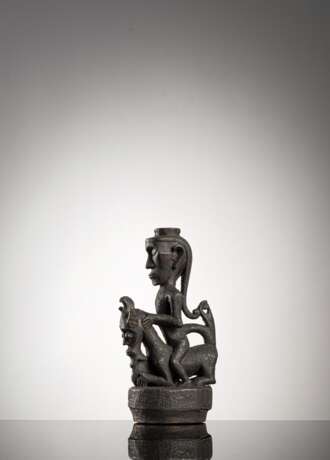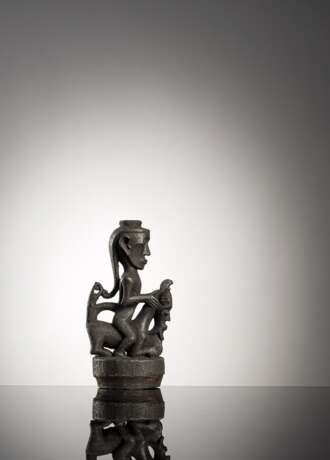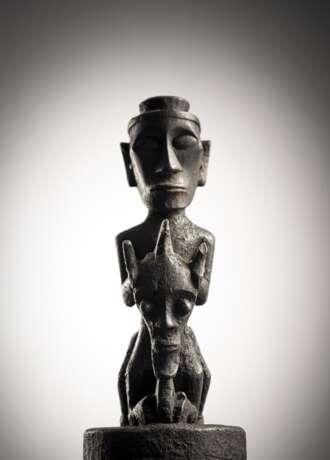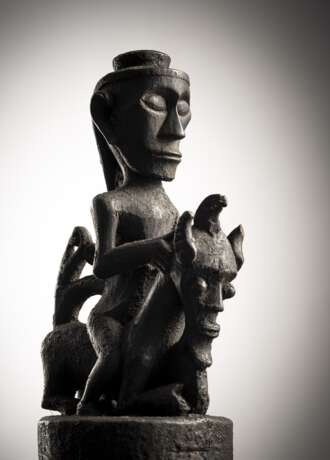ID 1218027
Lot 1510 | Deckel eines Betel-Kalkgefäßes ''kapur sirih'' aus Holz
Estimate value
€ 400 – 600
H. 23 cm
Ein vollplastisch geschnitzter Deckel für ein Kalkgefäß für sirih-Herstellung, tagan. Er ist aus patiniertem leichtem Holz und stellt eine auf einem singa reitende Gestalt mit einem hochgebundenen Haarschopf dar. Die dicke organische Patina verweist auf langjährigen Gebrauch und „Beopferung“. Die Beopferung hochrangiger Gegenstände erfolgte in regelmäßigen Abständen mit Alkoholika, dem Blut von Nutztieren sowie mit Betel versetztem Speichel, alles Substanzen mit eigener Seele. Die Vorderbeine des singa, der einen hochgereckten Schweif hat, ähneln menschlichen Armen; die Hinterbeine sind recht realistische Pferdebeine. Die Zahl der Hybridformen, die der singa annehmen kann, ist fast endlos. Das Gefäß, zu dem dieser Deckel gehörte, dürfte in einem Bambus-Internodium bestanden haben.Betel ist ein in ganz Südostasien verbreitetes Genussmittel. Üblicherweise werden die unreifen Betelnüsse dazu mit speziellen Scheren kleingeschnitten, gestoßen und in mit gelöschtem Kalk bestrichene Blätter gerollt, welche nicht von der Betelpalme, sondern vom Betelpfeffer (Piper betle) stammen, was dann als Betelbissen (sirih) bezeichnet wird. Die gestoßene Betelnuss, die eine gefäßerweiternde Wirkung hat, wurde mit Kalkpaste gemischt zu Pfriemen verarbeitet und gekaut. Für das „Ansetzen“ der Betel-Paste könnte das Gefäß dieses Deckels bestimmt gewesen sein. Wegen des bitteren Geschmacks werden häufig Gewürze wie Pfefferminze, Lakritze oder auch Kautabak hinzugegeben. Betelbehälter waren meist aus Horn oder Bambus, konnten bei den Toba-Batak jedoch auch aus Messing bestehen und waren geschätzte Prestigegegenstände. Da sie meist in Felltaschen (salipi) getragen wurden, aus denen nur der Deckel herausragte, verzichtete man am Korpus oft auf aufwendigen Dekor.
Aus einer alten deutschen Privatsammlung, seit den 1950er Jahren gesammelt - Minim. berieben, partiell wenige kleine Best.
Publ.: IFICAH (2018): Die Verwandtschaft im Nacken, Wohlesbostel. Seiten 80, 81
| Auction house category: | Ethnographic tribal art |
|---|
| Auction house category: | Ethnographic tribal art |
|---|
| Address of auction |
Nagel Auktionen GmbH Neckarstrasse 189 - 191 70190 Stuttgart Germany | ||||||||||||||
|---|---|---|---|---|---|---|---|---|---|---|---|---|---|---|---|
| Preview | |||||||||||||||
| Phone | +49 (0)711 649 690 | ||||||||||||||
| Fax | +49 (0)711 649 69696 | ||||||||||||||
| Buyer Premium | 29,5% | ||||||||||||||
| Conditions of purchase | Conditions of purchase | ||||||||||||||
| Business hours | Business hours
|






